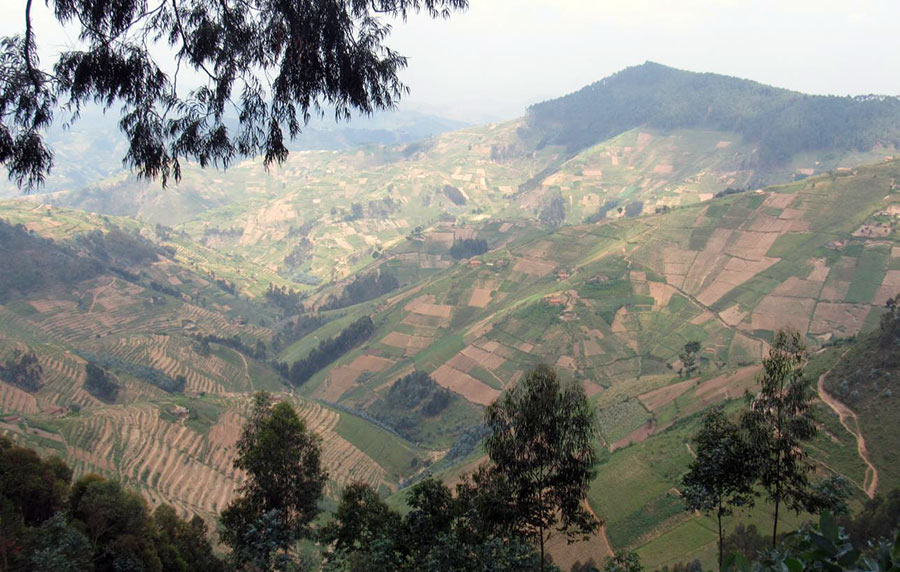
Gishwati – Mukura, Rwanda’s fourth national park is the closest to Kigali
On a drive from Lake Kivu towards Musanze, my eyes were drawn to the green cultivated hillsides behind the thin row of houses that line the main road. “This is Gishwati,” said Maurice. “One day it will be a National Park.”
I thought no more of his comment until a year later when I found myself sitting next to Dr Sam Kanyimibwa of the Albertine Rift Conservation Society, the organisation that facilitated the management plan for the new Gishwati – Mukura National Park.
This blog is based on information shared by ARCOS and the Rwanda Environment Management Authority. It’s a little geekier than my normal conservation and adventure stories but what a brilliant and ambitious project! You have to hand it to the Rwandans: they have vision.
Gishwati and Mukura Forests are two remnant forests which were designated as reserves in the 1950s. Although not physically joined, the government of Rwanda decided to establish a new national park that will – in time – link the two forest fragments of Gishwati and Mukura to create Gishwati – Mukura National Park.
Created in 2015, Gishwati – Mukura – Rwanda’s fourth national park – is now the closest National Park to Kigali. “This location is very special. It’s surrounded by tea plantations and pastoralism. It is a very beautiful mountain ecosystem,” Dr Kanyimibwa explained.

Gishwati-Mukura National Park is home to many species that are listed by IUCN as threatened or endangered. Among these is the Eastern Chimpanzee.
“Joining the two forest fragments of Gishwati and Mukura is positive. However, there is the challenge of species isolation,” explains Dr Kanyimibwa. The creation of Gishwati-Mukura National Park GMNP in Western Rwanda is “very interesting in terms of conservation,” he added.
In 2019, Rwanda Development Board (RDB) signed a 25-year concession agreement with Imizi Ecotourism Development to develop and operate “an exclusive chimpanzee and primate trekking experience under the Wilderness Safaris brand” one element in a multi-phased conservation and tourism management programme for the newly formed Gishwati – Mukura National Park.
Where is Gishwati-Mukura National Park?
Gishwati-Mukura National Park lies in North-West Rwanda (1° 49´ S, 29° 22´ E) and is part of the Albertine Rift and Congo-Nile Divide. The park is composed of montane rainforest fragments that are rich in biodiversity. GMNP’s tropical climate has an average temperature ranging between 20° and 24° C, the mean annual rainfall is between 1,500-1,600 mm and the elevation ranges from 2,000 to 3,000m above sea level.

Gishwati-Mukura National Park lies in North-West Rwanda (1° 49´ S, 29° 22´ E) and is part of the Albertine Rift and Congo-Nile Divide. The park is composed of montane rainforest fragments that are rich in biodiversity. GMNP’s tropical climate has an average temperature ranging between 20° and 24° C, the mean annual rainfall is between 1,500-1,600 mm and the elevation ranges from 2,000 to 3,000m above sea level.
History of Gishwati and Mukura Forests
More than hundred years ago, the forests of Mukura and Gishwati covered approximately 253,000 hectares and were Rwanda’s largest indigenous forests.
These forests cover just 3,558 hectares now (1,570 ha on Gishwati and 1,988 ha for Mukura), due to encroachment, large-scale cattle ranching, cattle grazing, resettlement of refugees after the genocide, illegal mining and plantations of non-native trees. If deforestation were to continue at the same pace, these forests would no longer exist by 2020. Subsistence activities such as mining, logging, collection of firewood, charcoal-making and sand quarrying further degrade the environment.
History shows that Mukura Forest, Gishwati Forest and Nyungwe Forest once formed a continuous forest. (The extension of forest into Burundi is known as Kibira Forest).
The creation of a corridor between Gishwati and Nyungwe through Mukura Forest aims to restore the ecological connectivity of these forests.
How is the new Gishwati – Mukura National Park being created?
Although there is more than 20 km of community land between the two forest fragments, conservationists are pinning their hopes on using a river – or more precisely, the land either side of it – to reconnect these two forests. The law states that people must respect 10 metres of land either side of the river – this gives conservationists an entry point. The Rwanda Environment Management Authority is now working to restore the highly degraded Gishwati-Mukura landscape through the “Landscape Approach to Forest Restoration and Conservation (LAFREC)” project.
The plan to connect the patches of forest by an ecological corridor is complicated by a complex mosaic of different land uses between the two forests.
However, the hills and valleys and GMNP are dominated by crops, pasture and non-native trees (mainly eucalyptus and pine).
The main human activity in the mountains around Gishwati-Mukura National Park is small-scale farming of maize, beans, Irish potatoes, bananas, tea and coffee. Some land is also used for pasture for livestock (cows, goats, sheep, and pigs) and forestry.
Biological highlights of Gishwati and Mukura
Although Gishwati-Mukura National Park has suffered a serious loss of biodiversity as a result of deforestation – fauna alone has declined by a mind-boggling 99% – nevertheless, GMNP still hosts significant biodiversity, including:
- 200 species of trees and shrubs including numerous hardwood trees and bamboo.
Many species that are listed by IUCN (International Union for Conservation of Nature) as threatened or endangered, including:
- Eastern chimpanzee. Gishwati-Mukura National Park and Nyungwe National Park (NNP) are the only remaining habitats for Eastern chimpanzees (Pan troglodytes schweinfurthii) in Rwanda.
- Golden monkey (Cercopithecus mitis kandti).
- Mountain monkey or L’Hoest’s Monkey (Cercopithecus l’hoesti).
- More than 200 species of birds, including Albertine Rift endemics Ruwenzori / Rwenzori Turaco (Gallirex johnstoni) and Grauer’s swamp-warbler (Bradypterus graueri).
- Amphibians such as brown forest frogs and multiple species of toads.
- Reptiles that include the Great Lakes Bush Viper and multiple species of chameleons.
- Satinsyi River is home to a highly endangered species of fish (Haplochromis erythromaculatus).

The ecological importance of Gishwati – Mukura National Park
The role played by these forests is vital to the local, regional and national economy.
GMNP channels run-off into the headwaters of Africa’s two largest hydrological systems: the Nile and Congo rivers. Gishwati and Mukura forests – with their many streams and riverbeds – regulate river flow and ensure that water is available throughout the year. The forests absorb and slowly release rainwater, preventing loss of topsoil, (preventing sometimes disastrous landslides). As such, Mukura-Gishwati Forest landscape is crucial for farming and primary industries such as tea and coffee.
The forests are home to birds, bats and insects that pollinate crops and aid in the natural control of insect pests. With massive deforestation, these benefits are not just lost locally but impact is felt miles downstream. Gisenyi town and surrounding areas depend on the Sebeya River for water and electricity. Bralirwa (Rwanda’s main brewery) depends on Sebeya for beer production.
In the future, the riverbank protection and forest plantation initiatives along Sebeya and Satinsyi rivers are expected to restore part of the ecological connectivity of the two forests.
What next for GMNP?
The establishment of Gishwati – Mukura National Park will boost conservation of the forests’ rich biodiversity and help restore habitats and offer better protection of threatened species.
Officials are pushing for the park to be recognised as a UNESCO World Heritage Biosphere Reserve. For local people, the new Gishwati – Mukura National Park brings the promise of jobs in the hotels and restaurants that will be established near the park and as guides and souvenir sellers. (Tourism globally employs 1 in 11 people).
Gishwati – Mukura National Park is Rwanda’s fourth national park. The others are Volcanoes National Park, Akagera National Park and Nyungwe National Park.
But can tourists visit now?
According to the Rwandan government’s tourism site, “activities in the park are due to begin in 2019 and include a guided nature hike, guided chimp and monkey tracking, bird watching and a visit to the waterfalls.
Community-based activities include a farm stay, a live cultural dance, making handicrafts, beekeeping, a tea plantation tour and the chance to learn from traditional healers, who use natural plants to support modern medicine and synthesised drugs.”
I’ve attended the highly professional Kwita Izina gorilla naming ceremony a number of times and was in Rwanda recently when black rhinos were being shipped to the country. Imagine this country’s tourism in a decade or more. It’s really quite something. It looks like exciting times are ahead for this new national park and tourism in general across Rwanda.



























UPDATE MAY 2022.
One of the highlights of my last few weeks research for Fodor’s Travel “Complete Guide to the African Safari” is visiting Rwanda’s tiny Gishwati Mukura National Park for the first time.
It is three years since I published this blog and finally I had a chance to visit this nascent National Park.
Thank you MURAKOZE to Anaclet of Rwanda Development Board (RDB) for giving me an insight into the park’s future direction: future tourism activities will include hiking, birdwatching, Eastern Chimpanzee tracking, camping, and numerous cultural experiences. I look forward to hearing more.
In the meantime, a tree planting programme is helping to protect the Gishwati Mukura landscape from further erosion, protect the rivers, improve biodiversity and – crucially – provide firewood for local communities. Improved charcoal practices give direct health, environmental and financial benefits. Combined, these initiatives generate more appreciation for conservation.
Excellent article thanks!
I am busy writing an article on Rwanda Primates on my website
Hi Nic
Thanks for the positive feedback 🙂
In terms of primates, Rwanda is best known for the mountain gorillas of Volcanoes National Park; but you can also track golden monkeys there. There is a sizeable group of chimpanzees open to tourists to track in Nyungwe Forest National Park, a superb rainforest in the south west of the country. Nyungwe also has a habituated group of black-and-white Colobus. Visitors can get within a few metres of them, in the company of a wildlife ranger.
Hi, do you know how to get to the forrest? Internet claims that we need to stay in one lodge, to get inside (https://fharwanda.org/?How-to-visit-Gishwati-Mukura-National-Park) Maybe you have some tip for one day trip?
Hi Justyna
Apologies for the delay in replying to you…
I’m not aware that you have to stay overnight in order to visit Gishwati-Mukura.
I visited the National Park HQ in 2022 on a day trip from Gisenyi while researching a guidebook.
The roads into the National Park are excellent (there are very few vehicles, or even boda bodas in these remote areas, but I believe the government is investing in tourism infrastructure, hence the new roads).
I visited the site of the guesthouse although did not stay there. I read some recent reviews that said you can camp on the same site and organise a barbeque, if you have your own equipment. That would mean an overnight stay would be a lot cheaper (but you would have to contact the guesthouse for more information). It’s a very beautiful corner of the country but imagine it will be very cold at night, particularly if you’re camping. It should be worth it though. With so few people around, you will almost have the forest to yourselves!